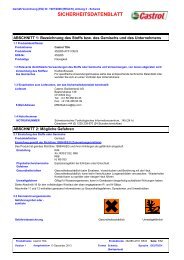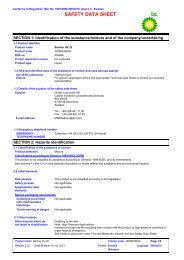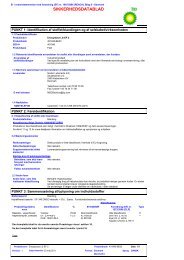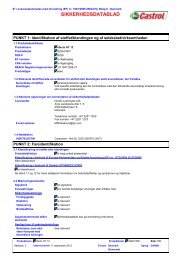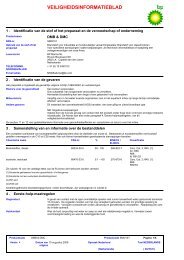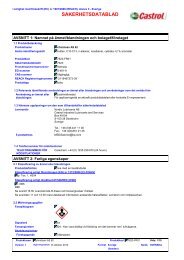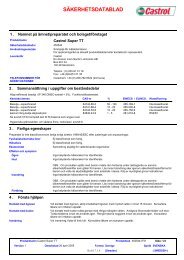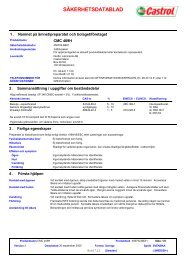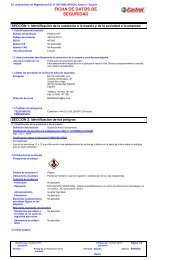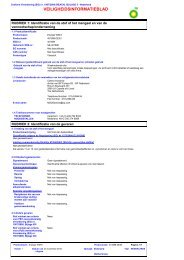(English (GB)) - BP - PDS & MSDS Search
(English (GB)) - BP - PDS & MSDS Search
(English (GB)) - BP - PDS & MSDS Search
You also want an ePaper? Increase the reach of your titles
YUMPU automatically turns print PDFs into web optimized ePapers that Google loves.
SAFETY DATA SHEET<br />
1 . Identification of the substance/preparation and company/undertaking<br />
Product name<br />
SDS no.<br />
TLX 988D<br />
451139<br />
Product use Brake fluids.<br />
For specific application advice see appropriate Technical Data Sheet or consult our company<br />
representative.<br />
Supplier<br />
EMERGENCY TELEPHONE<br />
Castrol (UK) Ltd<br />
Wakefield House<br />
Pipers Way<br />
Swindon<br />
Wiltshire SN3 1RE<br />
Carechem: +44 (0) 208 762 8322<br />
NUMBER Carechem: +44 (0) 208 762 8322 (24 hours)<br />
2 .<br />
Composition/information on ingredients<br />
Polyalkylene glycol ethers / glycols<br />
Chemical name<br />
CAS no. % EINECS / ELINCS. Classification<br />
Triethylene glycol monobutyl ether; 2-(2-(2-butoxyethoxy)<br />
ethoxy) ethanol<br />
143-22-6 10 - 20 205-592-6 Xi; R41<br />
2-(2-Methoxyethoxy)ethanol 111-77-3 5 - 10 203-906-6 Repr. Cat. 3; R63<br />
2-(2-Butoxyethoxy)ethanol<br />
See section 16 for the full text of the R-phrases declared above<br />
112-34-5 1 - 5 203-961-6 Xi; R36<br />
Occupational exposure limits, if available, are listed in section 8.<br />
3 .<br />
Hazards identification<br />
This preparation is classified as dangerous according to Directive 1999/45/EC as amended and adapted.<br />
Physical/chemical hazards Not classified as dangerous.<br />
Human health hazards Irritating to eyes.<br />
Possible risk of harm to the unborn child.<br />
Environmental hazards Unlikely to be harmful to aquatic organisms.<br />
Effects and symptoms<br />
Eyes Causes eye irritation.<br />
Skin Contains material which may cause birth defects based on animal data.<br />
Inhalation No significant health hazards identified.<br />
4 .<br />
Ingestion No significant health hazards identified.<br />
Eye contact<br />
Skin contact<br />
Inhalation<br />
First-aid measures<br />
In case of contact, immediately flush eyes with a copious amount of water for at least 15 minutes. Obtain<br />
medical attention immediately.<br />
In case of contact, immediately flush skin with plenty of water. Remove contaminated clothing and shoes.<br />
Wash clothing before reuse. Clean shoes thoroughly before reuse. Get medical attention if irritation<br />
develops.<br />
If inhaled, remove to fresh air. Get medical attention if symptoms appear.<br />
Ingestion Do NOT induce vomiting unless directed to do so by medical personnel. Never give anything by mouth to<br />
an unconscious person. If large quantities of this material are swallowed, call a physician immediately.<br />
Notes to physician Treatment should in general be symptomatic and directed to relieving any effects.<br />
Product name TLX 988D<br />
Product code<br />
451139-FR10<br />
Page: 1/5<br />
Version 1 Date of issue 21 October 2005<br />
Format United Kingdom<br />
(UK)<br />
Language ENGLISH<br />
Build 7.2.2 (United Kingdom)<br />
( ENGLISH )
5 .<br />
Fire-fighting measures<br />
Extinguishing media<br />
Suitable<br />
Not suitable<br />
Hazardous decomposition<br />
products<br />
Special fire-fighting<br />
procedures<br />
Protection of fire-fighters<br />
In case of fire, use foam, dry chemical or carbon dioxide extinguisher or spray.<br />
Do not use water jet.<br />
Unusual fire/explosion hazards None identified.<br />
Personal precautions<br />
Personal protection in case of<br />
a large spill<br />
These products are carbon oxides (CO, CO2). Some metallic oxides.<br />
None identified.<br />
6 . Accidental release measures<br />
Environmental precautions<br />
and clean-up methods<br />
7 .<br />
Handling<br />
Storage<br />
Handling and storage<br />
Fire-fighters should wear self-contained positive pressure breathing apparatus (SCBA) and full turnout<br />
gear.<br />
Immediately contact emergency personnel. Keep unnecessary personnel away. Use suitable protective<br />
equipment (See Section: "Exposure controls/personal protection"). Follow all fire fighting procedures (See<br />
Section: "Fire-fighting measures").<br />
If emergency personnel are unavailable, contain spilled material. For small spills add absorbent (soil may<br />
be used in the absence of other suitable materials) scoop up material and place in a sealed, liquid-proof<br />
container for disposal. For large spills dike spilled material or otherwise contain material to ensure runoff<br />
does not reach a waterway. Place spilled material in an appropriate container for disposal. Avoid contact<br />
of spilt material with soil and prevent runoff entering surface waterways. See Section 13 for Waste<br />
Disposal Information.<br />
Splash goggles. Full suit. Boots. Gloves.<br />
Wash thoroughly after handling.<br />
Keep container tightly closed. Keep container in a cool, well-ventilated area.<br />
Not suitable Prolonged exposure to elevated temperature<br />
8 . Exposure controls/personal protection<br />
Occupational exposure limits<br />
This product does not have any assigned OELs.<br />
Control Measures Provide exhaust ventilation or other engineering controls to keep the airborne concentrations of vapours<br />
below their respective occupational exposure limits.<br />
All chemicals should be assessed for their risks to health and appropriate control measures put in place<br />
to prevent or adequately control exposure. A hierarchy of control measures exists (e.g. elimination,<br />
substitution, general ventilation, containment, systems of work, changing the process or activity) that<br />
must be considered before use of personal protective equipment. Personal protective equipment<br />
should conform to appropriate standards, be suitable for use, be kept in good condition and properly<br />
maintained.<br />
Your supplier of personal protective equipment should be consulted for advice on selection and<br />
appropriate standards. Relevant information can be obtained from the European Committee for<br />
Standardisation http://www.cenorm.be/cenorm/index.htm.<br />
The final choice of protective equipment will depend upon a risk assessment. It is important to ensure<br />
that all items of personal protective equipment are compatible.<br />
Hygiene measures Wash hands after handling compounds and before eating, smoking, using lavatory, and at the end of<br />
day.<br />
Personal protective equipment<br />
Respiratory system Respiratory protective equipment is not normally required where there is adequate natural or local<br />
exhaust ventilation to control exposure.<br />
In case of insufficient ventilation, wear suitable respiratory equipment.<br />
Respiratory protective equipment must be checked to ensure it fits correctly each time it is worn.<br />
Air-filtering respirators, also called air-purifying respirators, will not be adequate under conditions of<br />
oxygen deficiency (i.e. low oxygen concentration), and would not be considered suitable where airborne<br />
concentrations of chemicals with a significant hazard are present. In these cases air-supplied breathing<br />
apparatus will be required.<br />
Provided an air-filtering/air-purifying respirator is suitable, a filter for particulates can be used for mist or<br />
fume. Use filter type P or comparable standard. A combination filter for particles and organic gases<br />
Product name TLX 988D<br />
Product code<br />
451139-FR10<br />
Page: 2/5<br />
Version 1 Date of issue 21 October 2005<br />
Format United Kingdom<br />
(UK)<br />
Language ENGLISH<br />
Build 7.2.2 (United Kingdom)<br />
( ENGLISH )
and vapours (boiling point >65°C) may be required if vapour or abnormal odour is also present due to<br />
high product temperature. Use filter type AP or comparable standard.<br />
Skin and body Use of protective clothing is good industrial practice.<br />
Cotton or polyester/cotton overalls will only provide protection against light superficial contamination that<br />
will not soak through to the skin. Overalls should be laundered on a regular basis. When the risk of<br />
skin exposure is high (e.g. when cleaning up spillages or if there is a risk of splashing) then chemical<br />
resistant aprons and/or impervious chemical suits and boots will be required.<br />
Hands Wear protective gloves if prolonged or repeated contact is likely.<br />
Recommended: Butyl gloves. Neoprene gloves.<br />
Protective gloves will deteriorate over time due to physical and chemical damage. Inspect and replace<br />
gloves on a regular basis. The frequency of replacement will depend upon the circumstances of use.<br />
Eyes Avoid contact with eyes. Chemical splash goggles.<br />
9 .<br />
Physical and chemical properties<br />
Auto-ignition temperature 310 °C<br />
Colour Amber.<br />
Odour Oily.<br />
Physical state Liquid.<br />
Boiling point / range<br />
>232 °C<br />
Melting point / range<br />
Density<br />
-50 °C<br />
1050 kg/m 3 (1.05 g/cm 3 ) at 20°C<br />
Solubility Soluble in water in any proportion.<br />
LogKow<br />
pH 7 to 9 at 25%<br />
The product is more soluble in octanol; log(octanol/water) >3<br />
Viscosity Kinematic: 2.29 mm 2 /s (2.29 cSt) at 100°C<br />
10 .<br />
Stability and reactivity<br />
Incompatibility with various<br />
substances<br />
Hazardous polymerisation Will not occur.<br />
11 .<br />
Toxicological information<br />
Acute toxicity<br />
Chronic toxicity<br />
Miscible in water. Strong oxidising materials Incompatible with some strong acids. Do not use in brake<br />
systems requiring mineral oil. On contact these fluids will soften and may lift industrial coatings and paints.<br />
Unlikely to cause more than transient stinging or redness if accidental eye contact occurs.<br />
Unlikely to cause harm to the skin on brief or occasional contact but prolonged or repeated exposure may<br />
lead to dermatitis.<br />
Unlikely to cause harm if accidentally swallowed in small doses, though larger quantities may cause<br />
nausea and diarrhoea.<br />
At normal ambient temperatures this product will be unlikely to present an inhalation hazard because of its<br />
low volatility. May be harmful by inhalation if exposure to vapour, mists or fumes resulting from thermal<br />
decomposition products occurs.<br />
Carcinogenic effects No component of this product at levels greater than or equal to 0.1% is identified as a carcinogen by<br />
ACGIH, the International Agency for Research on Cancer (IARC) or the European Commission (EC).<br />
Developmental and<br />
Contains material which may cause birth defects based on animal data.<br />
teratogenic effects<br />
Product name TLX 988D<br />
Product code<br />
451139-FR10<br />
Page: 3/5<br />
Version 1 Date of issue 21 October 2005<br />
Format United Kingdom<br />
(UK)<br />
Language ENGLISH<br />
Build 7.2.2 (United Kingdom)<br />
( ENGLISH )
12 . Ecological information<br />
Persistence/degradability<br />
Mobility Spillages may penetrate the soil causing ground water contamination.<br />
Bioaccumulative potential<br />
Inherently biodegradable.<br />
Other ecological information Miscible in water.<br />
This product is not expected to bioaccumulate through food chains in the environment.<br />
Environmental hazards Unlikely to be harmful to aquatic organisms.<br />
13 .<br />
Disposal considerations<br />
Disposal Consideration /<br />
Waste information<br />
14 . Transport information<br />
Where possible, arrange for product to be recycled.<br />
Dispose of via an authorised person/ licensed waste disposal contractor in accordance with local<br />
regulations.<br />
Not classified as hazardous for transport (ADR/RID, ADNR, IMDG, ICAO/IATA)<br />
15 .<br />
Regulatory information<br />
Label requirements<br />
Hazard Symbol(s)<br />
Indication of danger<br />
Risk phrases<br />
R63- Possible risk of harm to the unborn child.<br />
R36- Irritating to eyes.<br />
Safety phrases S2- Keep out of the reach of children.<br />
S36/37- Wear suitable protective clothing and gloves.<br />
S46- If swallowed, seek medical advice immediately and show this container or label.<br />
Contains 2-(2-Methoxyethoxy)ethanol<br />
EU regulations Classification and labelling have been performed according to EU directives 1999/45/EC and<br />
67/548/EEC as amended and adapted.<br />
Other regulations<br />
16 .<br />
Inventories<br />
Other information<br />
Full text of R-phrases referred<br />
to in sections 2 and 3<br />
History<br />
Date of issue 21/10/2005.<br />
Date of previous issue<br />
AUSTRALIAN INVENTORY (AICS): Not determined.<br />
CANADA INVENTORY (DSL): Not determined.<br />
CHINA INVENTORY (IECS): In compliance.<br />
EC INVENTORY (EINECS/ELINCS): In compliance.<br />
JAPAN INVENTORY (ENCS): Not determined.<br />
KOREA INVENTORY (ECL): Not determined.<br />
PHILIPPINE INVENTORY (PICCS): Not determined.<br />
US INVENTORY (TSCA): In compliance.<br />
R63- Possible risk of harm to the unborn child.<br />
R36- Irritating to eyes.<br />
R41- Risk of serious damage to eyes.<br />
No Previous Validation.<br />
Prepared by Product Stewardship Group<br />
Product name TLX 988D<br />
Product code<br />
451139-FR10<br />
Page: 4/5<br />
Version 1 Date of issue 21 October 2005<br />
Format United Kingdom<br />
(UK)<br />
Language ENGLISH<br />
Build 7.2.2 (United Kingdom)<br />
( ENGLISH )
Notice to reader<br />
All reasonably practicable steps have been taken to ensure this data sheet and the health, safety and environmental information contained in it is<br />
accurate as of the date specified below. No warranty or representation, express or implied is made as to the accuracy or completeness of the<br />
data and information in this data sheet.<br />
The data and advice given apply when the product is sold for the stated application or applications. You should not use the product other than for<br />
the stated application or applications without seeking advice from us.<br />
It is the user’s obligation to evaluate and use this product safely and to comply with al applicable laws and regulations. The <strong>BP</strong> Group shal not<br />
be responsible for any damage or injury resulting from use, other than the stated product use of the material, from any failure to adhere to<br />
recommendations, or from any hazards inherent in the nature of the material. Purchasers of the product for supply to a third party for use at work,<br />
have a duty to take all necessary steps to ensure that any person handling or using the product is provided with the information in this sheet.<br />
Employers have a duty to tell employees and others who may be affected of any hazards described in this sheet and of any precautions that<br />
should be taken.<br />
Product name TLX 988D<br />
Product code<br />
451139-FR10<br />
Page: 5/5<br />
Version 1 Date of issue 21 October 2005<br />
Format United Kingdom<br />
(UK)<br />
Language ENGLISH<br />
Build 7.2.2 (United Kingdom)<br />
( ENGLISH )



